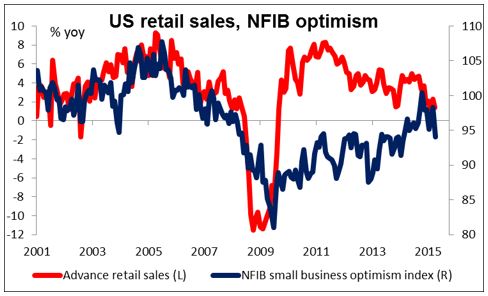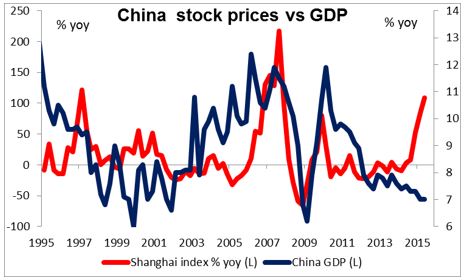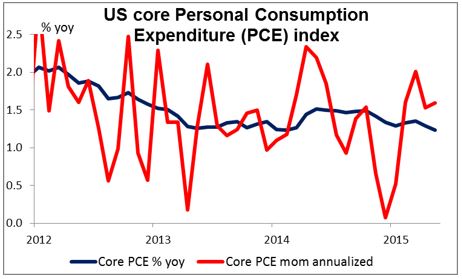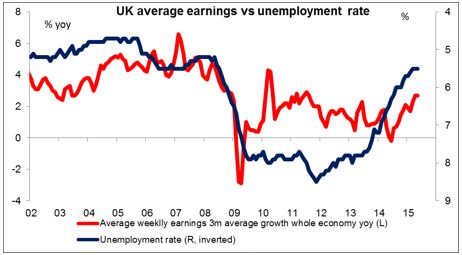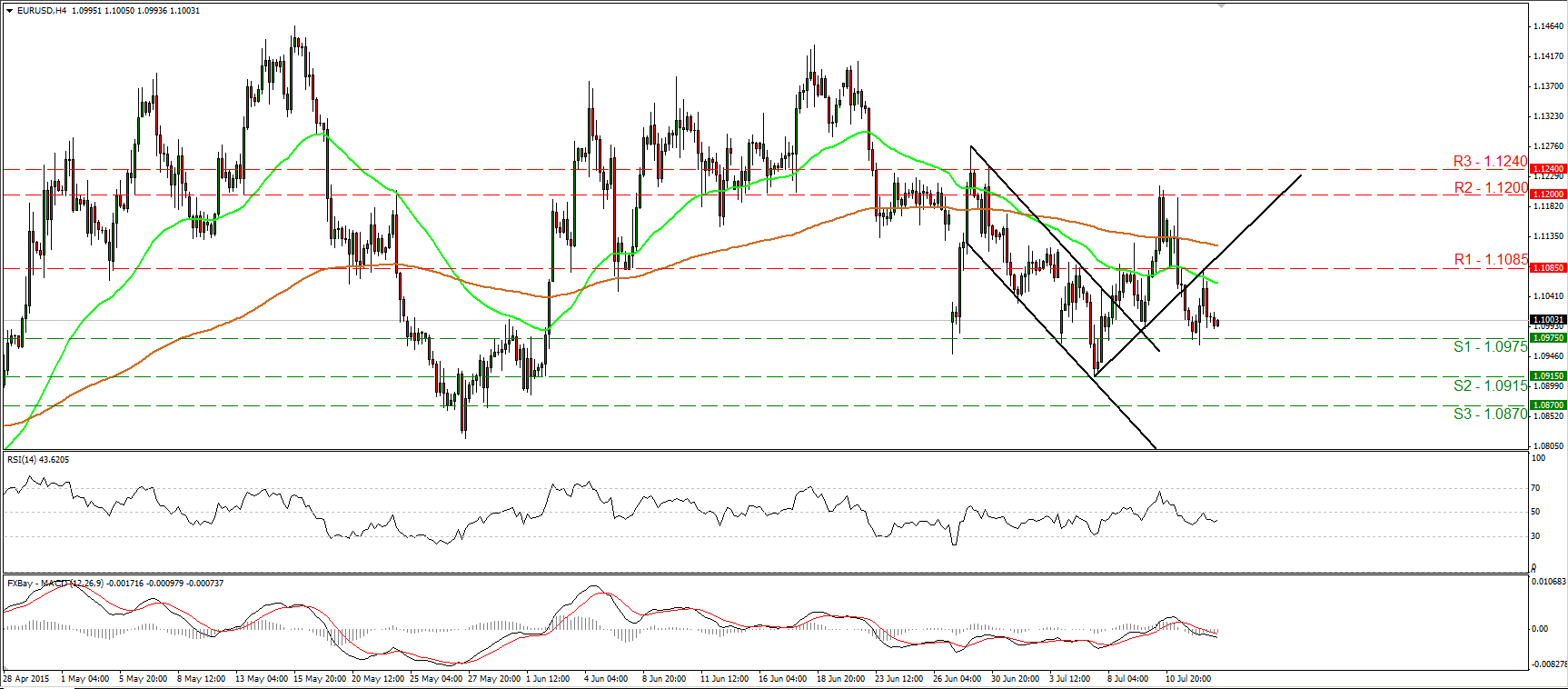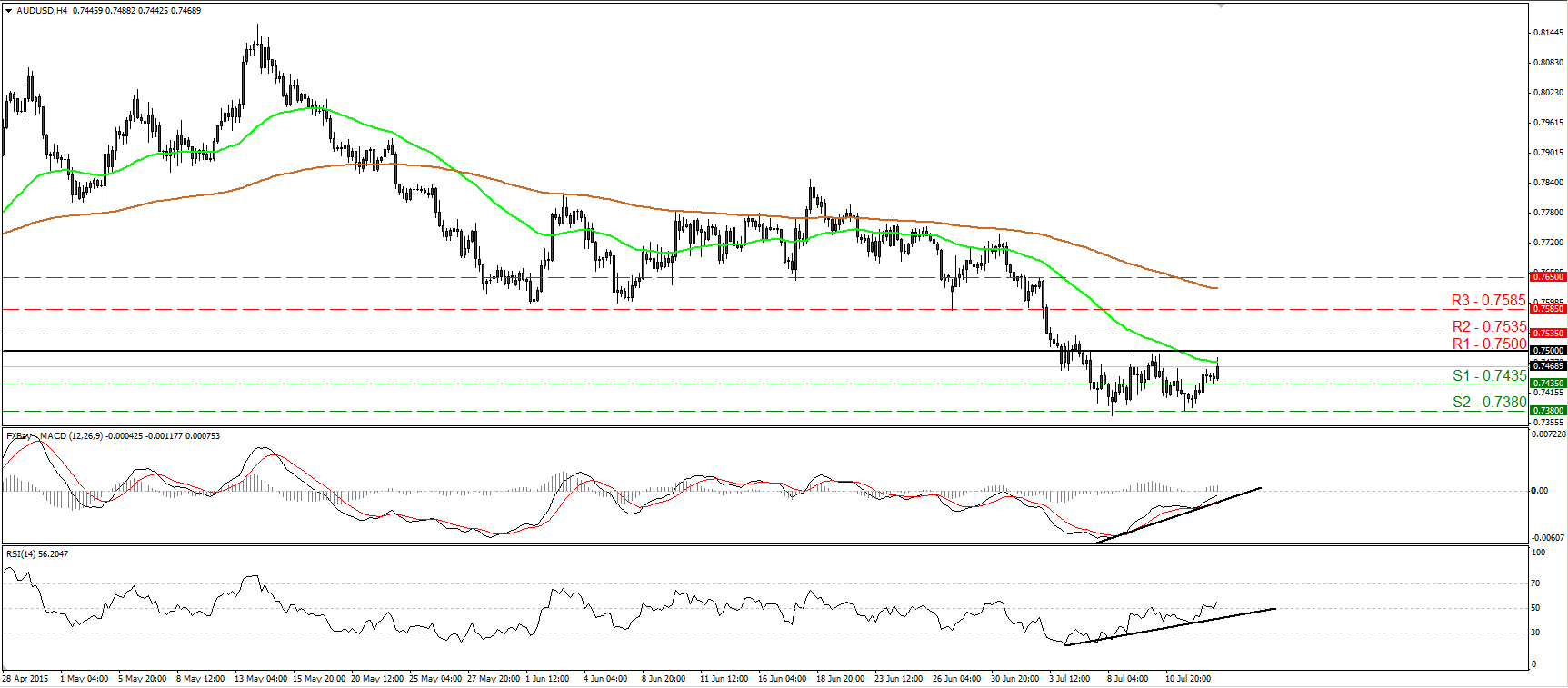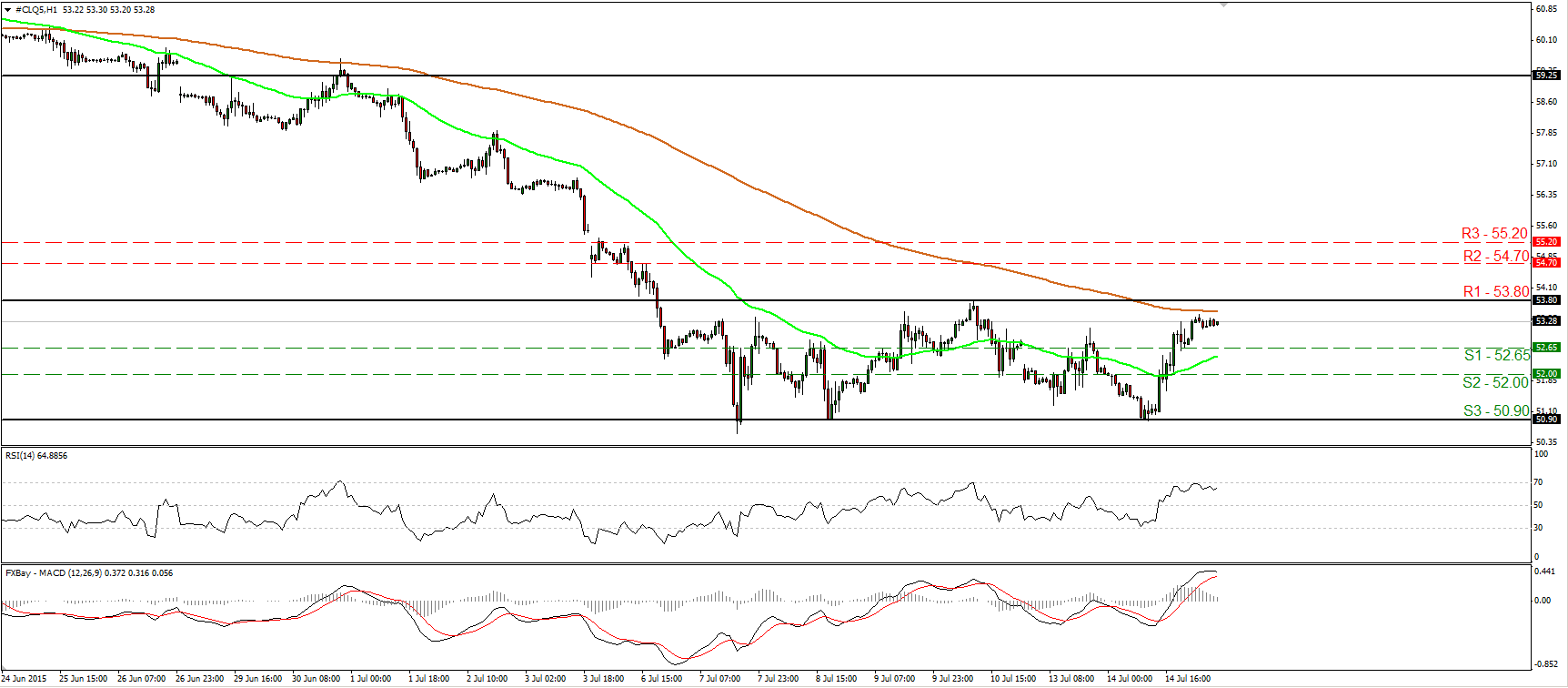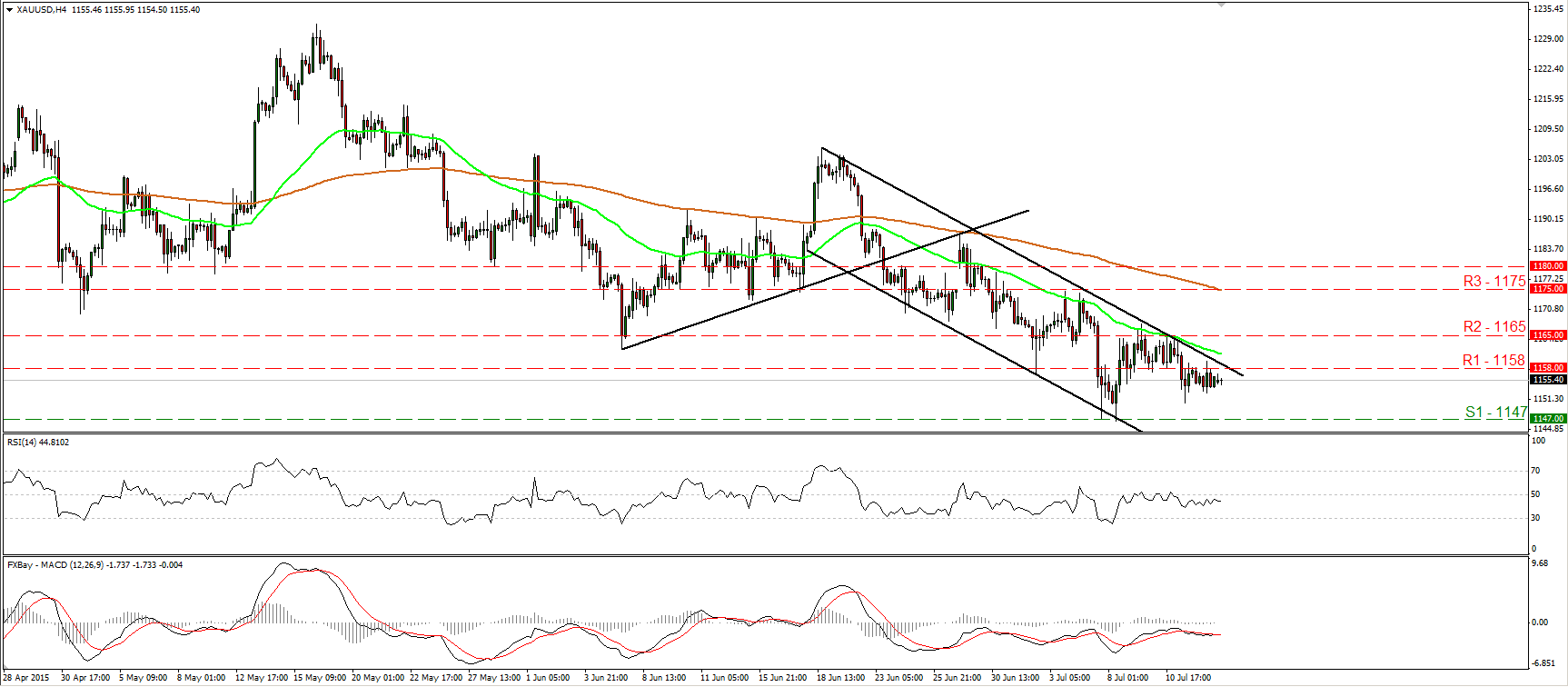• US indicators weak, Fed funds expectations retreat, USD falls Yesterday’s US economic news was generally disappointing. Retail sales unexpectedly declined in June and the May increase was revised down. At the same time, small business optimism fell sharply, with nine of the indicator’s ten components falling. “Not a recession signal, but not supportive of an optimistic view of growth in the second half,” according to the National Federation of Independent Business, which compiles the indicator. Fed funds rate expectations for next year and beyond fell 2.5 bps-4.0 bps. Nonetheless, the Atlanta Fed’s GDPNow model forecast for real GDP growth Q2 was 2.4% (qoq SAAR) on July 14, up from 2.3% on July 7.
• As Fed funds expectations retreated, the dollar weakened against most currencies, the notable exceptions being NOK and SEK. NOK weakened sharply on the Iranian nuclear settlement. It recovered somewhat as oil prices rebounded, but still remained below its previous-day levels. The rebound in oil prices was due to expectations that it will take some time for Iranian oil to hit the market (true, but in any event it’s less profitable to buy oil now and hold it for future delivery, which should bring down both spot and future prices). SEK weakened yesterday on lower-than-expected inflation numbers (more accurately, deeper-than-expected deflation numbers) and while it too recovered somewhat of its losses, failed to recover all.
• The currency’s course today will depend on what Fed Chair Yellen says (see below). The market is still much less hawkish than she is – while she is talking about at least one rate hike this year, the market is expecting that normalization won’t start until next year. Thus, there is still plenty of room for market expectations to change and the dollar to strengthen.
• China growth beats expectations, but stock market doesn’t care The several Chinese economic indicators that came out this morning all beat expectations, but the stock market didn’t care – stocks were down anyway. Second-quarter GDP rose 7.0% yoy, the same as in Q1 and higher than the market’s expectation of a slowdown to +6.8% growth. Retail sales, industrial production and fixed asset investment for June were all higher than in May, beating market forecasts. The data suggests that the government’s stimulus measures are starting to have an effect in helping to boost growth. Yet Chinese stocks were down around 2.4% this morning. One possible explanation is the old “good news is bad news” theory – that since the data were good, the government may slow down further stimulus measures. In any case, the contrast highlights the long-standing disconnect between Chinese stocks and economic fundamentals.
• BoJ stands pat as it maintains ridiculous forecast The Bank of Japan kept its quantitative and qualitative easing (QQE) program unchanged Wednesday morning as it maintained its (probably unattainable) inflation forecast. The Bank lowered its FY2016 inflation forecast slightly to 0.7% yoy from 0.8% yoy, but kept the FY2017 forecast at 1.9% yoy, thereby allowing it to maintain the fiction that it would achieve its 2% yoy inflation target on schedule. The current inflation rate according to that measure is 0.1% yoy, just barely above deflation. Although the recent output and export data has been disappointing, officials expect the relatively tight labor market to push up wages and thereby cause inflation to accelerate. We’ll see what happens in October, when the BoJ updates its twice-yearly Outlook for Economic Activity and Prices, where its formal forecasts appear.
• My view on the Greek settlement I think the Greek settlement was a lose-lose proposition. On the one hand, the attempt to eject a euro member weakens the strength of monetary union by turning it back into just another version of the Exchange Rate Mechanism, with all the weaknesses of that system. Moreover, Greece was humiliated. On the other hand, as Gideon Rachman so perceptively pointed out in the FT, once again, Germany went to the last minute of negotiations and folded – it may have added a bunch of restrictions and humiliations, but at the end of the day, it did agree to bail out Greece. In that respect, this round of negotiations went exactly like all the previous rounds, and so perhaps the market was correct in pricing in little risk of a Grexit.
• Still don’t believe that things are going according to plan? On Friday I mentioned that this kind of crisis was the way the Eurozone was expected to work. Jean Monnet, the EU's godfather, argued that “Europe will be forged in crises, and will be the sum of the solutions adopted for those crises.” He explained why: “People only accept change when they are faced with necessity, and only recognize necessity when a crisis is upon them.” This idea was corroborated by former US Treasury Secretary Tim Geithner, who related the following story in his book Stress Test:
• A few days later [i.e., late July 2012], I flew to meet Wolfgang Schäuble for lunch during his vacation…He told me there were many in Europe who still thought kicking the Greeks out of the eurozone was a plausible — even desirable — strategy. The idea was that with Greece out, Germany would be more likely to provide the financial support the eurozone needed because the German people would no longer perceive aid to Europe as a bailout for the Greeks. At the same time, a Grexit would be traumatic enough that it would help scare the rest of Europe into giving up more sovereignty to a stronger banking and fiscal union. The argument was that letting Greece burn would make it easier to build a stronger Europe with a more credible firewall. (emphasis added)
• Everyone knows about Greece I just returned from a trip to London. When going through Immigration, the immigration officer asked me my occupation. “Economist,” I said. “And what are you doing in the UK?” she asked. “I’m going to appear on Bloomberg TV Monday morning,” I replied. She laughed and said, “I’ll bet you’re going to talk about Greece!” You know a financial story is big when people who have no relation to the financial world know all about it.
• Lots more negotiations to come Note by the way that Greece’s economy minister said the €50bn in assets that Greece is supposed to pledge to privatize “obviously do not exist,” and added, “I don’t think we will proceed with real privatizations.” Moreover, the IMF has said that it might not be able to participate in the new bailout program if European creditors don’t offer Athens substantial debt relief because the organization’s rules forbid it from participating in a bailout if the country’s debt is deemed unsustainable and there’s no prospect of it returning to the bond market for funding. But Germany has steadfastly opposed further debt relief, so this would be politically difficult if not impossible. Somehow, I think we haven’t heard the last of Greece.
• Today’s highlights: The highlight today will be the Fed Chair Janet Yellen’s twice-a-year report on monetary policy to Congress (the House of Representatives on Wednesday and the Senate on Thursday). We will be looking for confirmation that the Fed is still on track to raise rates later this year. Yellen said on Friday that “(b)ased on my outlook, I expect that it will be appropriate at some point later this year to take the first step to raise the federal funds rate and thus begin normalizing monetary policy.” But one hike or two? And how does the resolution of the Greek crisis (for now) affect her thinking? What’s her view on inflation? While the annual rate of core Personal Consumption Expenditure (PCE) inflation, the Fed’s preferred measure, has slowed, the month-on-month change has accelerated and has averaged 1.7% annualized over the last three months – near the Fed’s 2% target. What’s her view on this? Stay tuned!
• The Bank of Canada meets today. The forecast is for the Bank to cut rates by 25 bps. Coming on top of the lower oil prices in the last few weeks and the contraction of GDP in April, the Bank could act again to revive growth. The Bank will also release its monetary policy report with updated economic forecasts, and Governor Poloz will hold a press conference following the rate decision. Even if the Bank remains on hold, given that the outlook of the Canadian economy has deteriorated somewhat, CAD is likely to come under renewed selling pressure, in our view.
• In the UK, we get the unemployment rate for May. Another decline in the rate and acceleration in the growth of average weekly earnings could bring the BoE’s hawks out in force and strengthen GBP. With UK inflation rate back to zero, market participants will be closely watching the labor data for signs of demand-pull inflation. Coming on top of BoE Gov. Carney’s comments, the time for a rate increase is moving closer. We expect GBP to remain well supported.
• In Sweden, Riksbank releases the minutes of its July policy meeting. At this meeting, the Bank surprised the markets and cut its key rate further into negative territory and expanded its bond purchases program. Given that the country’s inflation rate dipped back into deflation on Tuesday, thinking retrospectively, the decision seems correct.
• In the US, industrial production for June is expected to rebound from the month before, while the Empire State manufacturing index is expected to show that business conditions for NY manufacturers have improved in July. Although a rebound in industrial production could prove USD-positive, investors are likely to put more attention on Yellen’s testimony.
The Market
EUR/USD hits resistance at 1.1085 and then slides
• EUR/USD traded higher during the European morning Tuesday, but the advance was halted by the 1.1085 (R1) territory and then the rate tumbled again. This printed a lower high. Combined with the fact that the rate remains below the short-term uptrend line taken from the low of the 7th of July, I consider the short-term outlook to stay negative. A decisive move below 1.0975 (S1) is likely to set the stage for extensions towards our next support hurdle of 1.0915 (S2). In Yellen’s testimony today, market participants would be looking to see if the Fed is still on track to raise rates and if she considers September still the most likely month to do so. If so, this could encourage the bears to push the rate below 1.0975 (S1). Our oscillators continue to show negative momentum, and support the case that further declines could be looming. The MACD stands below both its zero and signal lines, while the RSI declined after hitting resistance at its 50 line. As for the bigger picture, I maintain my flat stance. I believe that a move above the psychological zone of 1.1500 is the move that could carry larger bullish implications, while a break below 1.0800 is needed to confirm a forthcoming lower low on the daily chart and perhaps turn the overall bias back to the downside.
• Support: 1.0975 (S1), 1.0915 (S2), 1.0870 (S3)
• Resistance: 1.1085 (R1), 1.1200 (R2), 1.1240 (R3)
AUD/USD rebounds after China’s GDP data
• AUD/USD traded higher during the Asian morning Wednesday, following the better-than-expected Q2 GDP data from China. Looking at our short-term oscillators, I see signs that the rebound could continue, perhaps even above the psychological zone of 0.7500 (R1). The RSI emerged above its 50 line, while the MACD stands above its trigger line and is headed towards its zero line. What is more, there is positive divergence between both these indicators and the price action. A clear move above the 0.7500 (R1) barrier could initially target the next resistance at 0.7535 (R2). Another break above that could pave the way for the 0.7585 (R3) hurdle. On the daily chart, the completion of a head and shoulders formation and the move below the psychological zone of 0.7500 signaled the continuation of the prevailing long-term downtrend, in my opinion. As a result, I would treat any further short-term advances as a corrective move of that long-term downside path.
• Support: 0.7435 (S1), 0.7380 (S2), 0.7330 (S3)
• Resistance: 0.7500 (R1), 0.7535 (R2), 0.7585 (R3)
GBP/JPY continued higher ahead of the UK employment data
• GBP/JPY continued to trade higher on Tuesday and now is headed towards the 193.60 (R1) resistance obstacle. As long as the pair is trading above the prior downtrend line and above the short-term uptrend line, I would consider the short-term picture to stay positive. A decisive break above the 193.60 (R1) line is likely to set the stage for extensions towards our next hurdle of 194.60 (R2). Today, we get the UK employment data for May, and expectations are for average weekly earnings to have accelerated. That could be the trigger for the aforementioned break. Our short-term oscillators detect strong upside speed and support the notion as well. The RSI continued higher and just poked its nose above its 70 line, while the MACD stands above both its zero and signal lines, pointing north. On the daily chart, I see that the 185.00 psychological zone stands pretty close to the 50% retracement level of the 14th of April – 24th of June rally. As a result, I would treat the 24th of June – 8th of July decline as a corrective phase, and I believe that the longer-term uptrend is gearing up again.
• Support: 192.00 (S1), 190.70 (S2), 189.25 (S3)
• Resistance: 193.60 (R1), 194.60 (R2), 195.80 (R3)
WTI trades in a sideways range
• WTI traded higher yesterday, but the advance stayed limited below the 53.80 (R1) resistance line. WTI has been oscillating between that barrier and the support hurdle of 50.90 (S3) since the 6th of July. As a result, I would consider the short-term picture to be neutral. Taking a look at our hourly oscillators, I see that the 14-hour RSI hit resistance at its 70 line and turned down, while the hourly MACD, although positive, has topped and could fall below its trigger line soon. These signs support the idea that the next leg is likely to be negative and that the price will stay within the range. Only a decisive move above 53.80 (R1) could signal the upside exit from the range and could initially target the 54.70 (R2) barrier. On the daily chart, the medium-term trend remains negative, and as a result I would consider any short-term advances as a corrective phase of that downside path. A clear break below 50.90 (S1) would confirm a forthcoming lower low, and perhaps open the way for the psychological zone of 50.00 (S2).
• Support: 52.65 (S1), 52.00 (S2), 50.90 (S3)
• Resistance: 53.80 (R1), 54.70 (R2), 55.20 (R3)
Gold trades in a consolidative manner below 1158
• Gold traded in a consolidative manner yesterday, staying below the resistance line of 1158 (R1) and within the short-term downside channel that had been containing the price action since the 18th of June. As long as the metal is trading within that channel, the near-term outlook remains somewhat negative, in my view. I would expect sellers to eventually push the rate for another test at the support barrier of 1147 (S1). A break below that hurdle would confirm a forthcoming lower low and is likely to challenge the 1142 (S2) line, defined by the lows of the 1st of December and 17th of March. Our short-term momentum studies stand near their equilibrium lines and point sideways, confirming yesterday’s trendless mode. Nevertheless, both these indicators are still within their bearish territories, supporting somewhat that the yellow metal is possible to trade lower in the near term.
• Support: 1147 (S1), 1142 (S2), 1132 (S3)
• Resistance: 1158 (R1), 1165 (R2), 1175 (R3)

